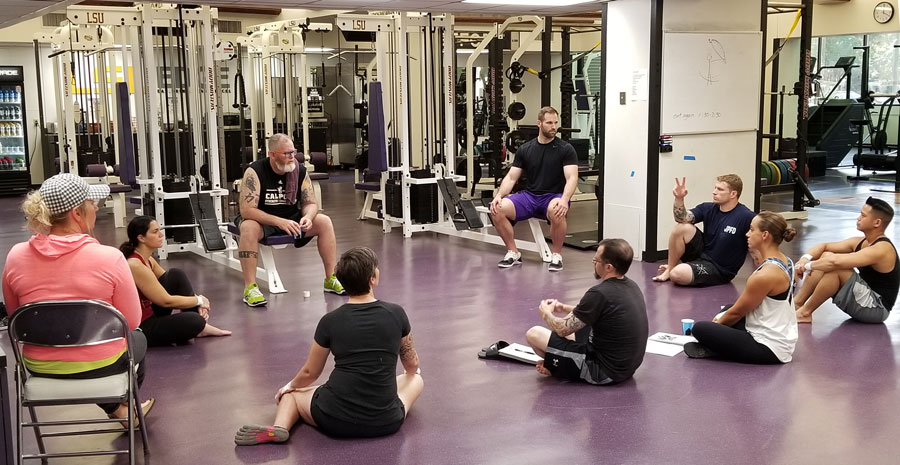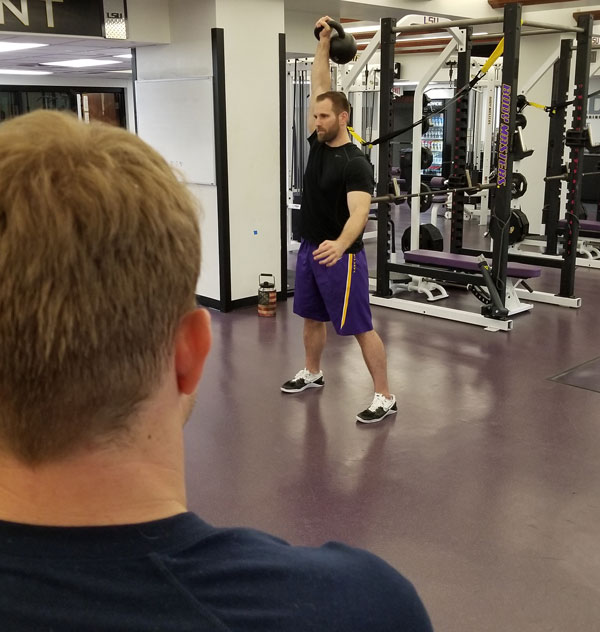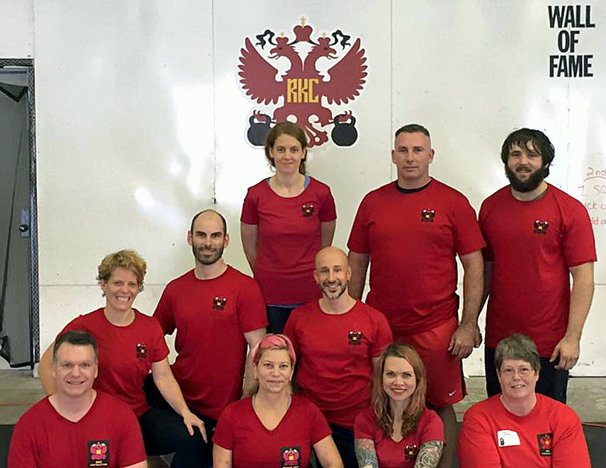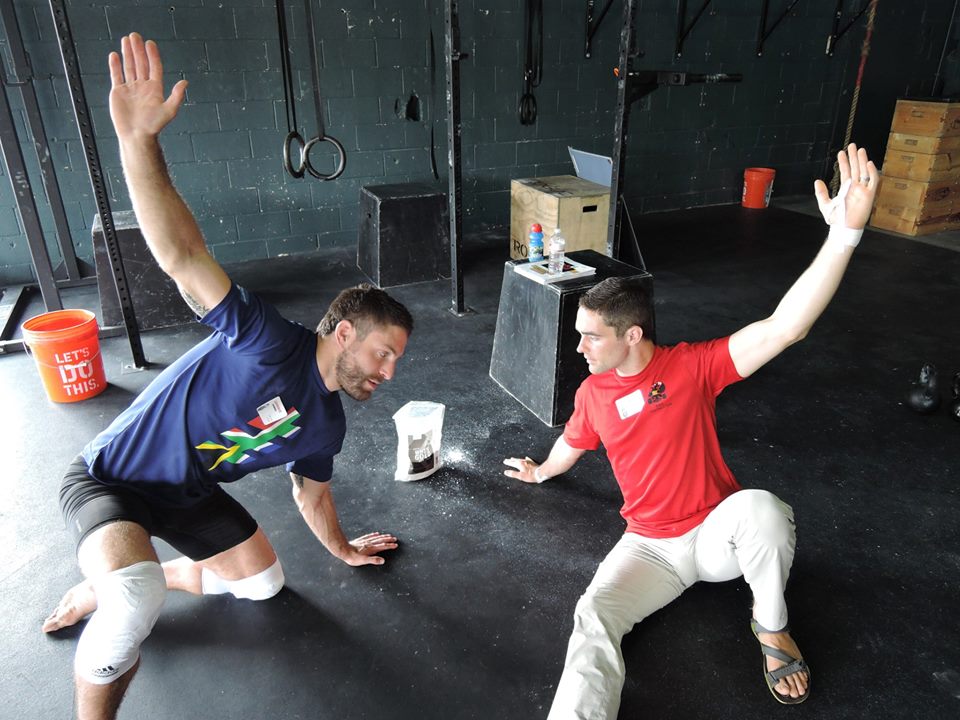
After attending and passing an HKC or RKC Workshop, we’ve done countless swings, feel confident about the material, and want to present the ideas we’ve learned to our clients. If you are like me, you’ve invested a ton of time and effort into other training systems. And you know that it’s difficult to integrate all the moving parts into a single sensible flow of program design.
During a certification weekend, I make a point to lecture on how to coach. “How to coach” is a drastically different subject than “what to coach”. The RKC manual and the instruction protocols we follow to teach the exercises are very thorough. If you’re a smart coach and refer back to the manual, most cases are very simple. But, how to coach it all—that’s an entirely different conversation.
Is this article about coaching style? Yes and no. Is it about coaching procedures? Sort of… I define coaching as the entire approach when teaching the material, the techniques, and the expected intensities for a given set. For great coaches, this is effortless. But, new coaches will need to make a conscious effort to develop the coaching muscle memory before it can become automatic. After twenty years in the college strength and conditioning world, I can confidently tell you that I’m there—but it took time. In this post, I will outline much of what I teach about coaching.
What Modality Are You Teaching?
Kettlebells, Olympic lifts, TRX, and CrossFit all have certain inherent personalities—and your temperament should fit the training setting. For example, when coaching the Olympic lifts, there is a massive psychological component with an athlete who is attempting a personal best. In that moment, you might go from being a coach to a psychotherapist. You might help them manage fear and hesitancy instead of yelling and trying to fire them up.
It’s extremely important to clearly understand the nature of what you are coaching. A yoga instructor yelling for their students to perform various poses will probably not be a yoga instructor for very long. It’s a ridiculous but clear example.
The RKC is a high tension program, which also means it’s high effort. So, an instructor using a very calming yin tone will likely not help their trainee get the most out of a nasty kettlebell swing ladder.
Embody the spirit of what you are coaching.
Who Are You Coaching?
One of my favorite things about the CrossFit community is that the members know today will not be easy. The programming always includes a big push at some point. If I were a box owner, I would assume that most of my clients have some edge, and that I can take them to some of the outer realms of fatigue, burn and through certain pain thresholds.
Conversely, I will never forget my first paying personal training client. At the time I had been coaching college kids for about seven years when I got an email from a woman who had some back pain and wanted to hire me for kettlebell training. We exchanged emails, agreed on a price and planned our first meeting the coming Saturday.
Remember, I had been coaching bulletproof 18-22-year-olds for years—and a severely deconditioned, 70 year old woman who was about 50 pounds overweight walked in! She was carrying two 2lb kettlebells with plastic handles attached to nylon straps which formed what can only be described as oversized hacky sacks. She insisted on using them. While I wanted to ask her where the hell she found that nonsense, I knew that my tough-guy approach was not going to work. I suddenly had to learn how to work with a brand new demographic. Thankfully, I knew that an elderly woman would not respond to me screaming at her to pick up the weight!
Know Your Stuff
Know the information cold, in your sleep, without thinking. Make sure you refer to your RKC or HKC manual many times after your certification weekend. I’ve had the profound luxury of training between 300-500 athletes every day, Monday through Friday. At minimum I’ll led 1,500 individuals in their training (in groups of course) each week. Regardless of the season, my athletes do 100 swings a day. So, that’s 150,000 swings that I could potentially dissect and critique each week. Most personal trainers won’t see that many swings in a year.
My coaching uptake is fast simply because I’m truly immersed in it daily. I see a slew of funky swings, tons of just-right swings, and more horrible swings than any one person should ever have to see. Every day I quickly analyze and pump out corrections at a blistering pace. I’m not a genius, I simply have critiqued—and continue to critique—countless reps.
Watch everything, be an observer at all times. Watch other people’s clients so you can bank reps. Record your own reps with your phone and critique yourself. Be a student every waking moment of the day and deconstruct what you are seeing—pass everything through your RKC filter. Mentally pick apart what you see to sharpen your blade.
I can coach anyone, and it’s not because I’m special. It’s because I’ve been able to constantly analyze and coach for years without pause. It’s nothing you can learn from a book or at a certification weekend. You have to do the time, put in the reps, and see as many repetition attempts as possible.
What To Watch
A good coach has a very specific eye for watching reps. Each exercise has lists of technical requirements. But, all of our movements begin with the feet on the floor—even the get-up. As you watch your clients or athletes train, your eyes should first go to their feet. Many technical errors in the top half of the body can be remedied by correcting the feet—not the chest, shoulder, or even the back. Our feet connect the movement to leverage, support posture, and give the athlete a foundation. The feet are the gateway to all things good. So, your eyes should start at the feet and return there throughout the set.
Breathing is also a frequent cause of technical flaws. When do they inhale? When do they exhale? Are they exhaling completely, or are they sipping and leaking? Know the answers, have a game plan for their breathing, and then coach it. Breathing is more listening than watching.
We have very clear standards for all of our movements. You know them because you were responsible for learning and demonstrating them at your RKC or HKC workshop. We don’t just enforce the standards to complicate the RKC weekend, we enforce them because they almost guarantee safety and without question ensure top performance. You need to coach those standards and elements. While we all eventually develop some degree of stylistic variations of our own, before you teach them to your clients, they should already have a firm handle on the basics. Look for the basics as you watch, and correct accordingly.
Lastly, I want you to pay particular attention to the head and neck. The RKC and HKC curriculum is filled with huge, dynamic movements. We need to understand the potential range of motion of the individual spinal joints. Joints are meant to move—until they are not. Whenever the body is loaded, the spine should stay motionless, unless the exercise is specifically designed for the spine to twist, rotate, flex or extend. The spine doesn’t stop at the shoulders, and most trainers forget that the neck is still part of the spine. I have multiple stories that will give you the chills involving athletes simply turned their heads while under load and breaking their backs. So, without getting into too much gore, the head and neck need to stay relatively motionless any time while the athlete is under load. Correct this immediately.

Positioning Is Everything
While it is important to watch reps, your orientation to the athlete while observing the reps is just as important.
Unless you are a seasoned pro, you should never watch a rep while standing directly in front of the athlete. Conversely, watching someone from behind is not only a very poor position for catching technical errors, it’s also incredibly creepy. Don’t be a creep.
The best location to watch reps and get the largest amount of information is in front and at a 45 degree angle. This is the most optimal spot for nearly all training methods, not just kettlebell training. It gives you the opportunity to see the most movement through several planes of motion. If you can’t stand at 45 degrees for some reason, then standing directly to the side is the next best option.
Intensity
The word HardStyle should say it all. But, after all my years of coaching one fact is very clear: most coaches and trainers don’t fully understand how much intensity they want from their athletes or clients. They don’t know how hard they should go!
With the grinds, we usually work in sets of 5, 3, and 1, and most of the intensity is handled within the programming. But, if you program your clients’ intensity along with sets and reps, they will make even greater progress in less time. For example, let’s consider pressing 3 sets of 5 reps for each arm. You could tell your client to use a 1:5 tempo (1 or burst up followed by a 5 or slow return). You can use any tempo (1:5, 1:2, 3:2, 5:1…) and any combination of ups and downs to really dial in the intensity.
During RKC Certifications, we teach an “effort dial” drill. While you do kettlebell swings for a set of 10, we yell percentages: 80%, 70%, 60%, 100%, etc. This drill quickly teaches how to dial effort up and down in the real world. But, if I am being totally honest, if you aren’t swinging 100% on all the reps, you are wasting time.
Most people don’t know what hard is, so show them. Most of your clients have never ventured into the pain cave. They might think they have, but most have no idea what it means to push. Show them, but be smart and safe. Let them have a real “that was the absolute maximum I could give and couldn’t muster one more” experience. They will thank you.
Be A Tremendous Communicator
Tremendous… read everything. Expand your vocabulary in general and within the realm of training. I’m notorious for saying that we need to have 14 different ways for saying the same thing. Be comfortable communicating because it is the life blood of your business. If you can’t communicate what you know, who cares what you know!
I studied Neuro Linguistic Programming (NLP) for two years so I could refine my ability to communicate. Do you need to do that? No, but you should… or you should study something like it. There are multiple ways to communicate with your clients—it’s not all just verbal. When you are trying to get an athlete to push, your words alone might not do it. The tone, volume, and pace of your speech as well as your body language all effect what your client hears and understands. Own all aspects of your communication so the people under your watchful eye clearly understand on what you want.
10 Questions
I drive my assistants and athletes crazy with “10 Questions,” but it’s incredibly effective. Regardless of what I’m teaching to a group—even if it’s review—I end every section with 10 Questions. My students know that we will sit for the rest of the afternoon until they ask me ten questions related to the information we just covered.
This fall, about 100 new athletes will come into my facility to begin their journey as a Cal Poly Mustang. One of the first things I will teach them is how to do kettlebell swings. For most of them, this is their first experience with kettlebells. Since I coach at such a frenetic pace, I have to know that they are absorbing the information. So, we teach for 30-45 minutes, and then regardless of the size of the group, we gather and they are required to ask me 10 questions. This forces us to communicate. Again, I have been talking a mile a minute at them in the session. I need to know if what I’ve tried to convey has reached them. They raise their hands, or I pick on the ones who are trying to hide. Either way, we break the ice and this helps the athletes become more willing to speak to me next time.
It also puts me on the spot. 10 Questions happens several times a day, especially during heavy instruction times. You wouldn’t believe some of the off the wall ideas going through the minds of these athletes. At times they ask questions I’ve never heard before, and it forces me to think. I have had countless “ah-ha” moments mid-sentence while working through an explanation. And if they truly stump me, I have no problem telling them that I don’t know, but will get them an answer as soon as possible.
For those of you who have taken an RKC or HKC where I was the lead instructor, you all know too well about 10 Questions. I do this at every certification I lead, several times a day. 10 questions is beneficial for a deeper understanding, and it quickly creates rapport between the class and myself, but also within the group of attendees. By the end of day one, they have all asked several questions and they naturally become more willing to speak up as the course progresses.
Lastly…
The moment you think you “have it” is the moment you have lost your way. Many of you would faint if you saw my resume, list of experiences, degrees, mentorships and certifications. I’m very lucky. I’ve learned from the absolute best in the world in a myriad of disciplines. My list of mentors is a who’s who of strength and fitness legends. And after all of this, I know that I’m just scratching the surface. The more I learn, the more I realize how much more I need to learn.
Be a student at all times. Listen to everyone—even the folks you think are full of crap. Every time you close your mouth and listen, you will learn something. Approach each day as an opportunity to forge your coaching craft. Read anything you can, attend workshops and certifications on modalities that you might not think are useful. Listen to podcasts and interviews about the movers and shakers in the industry. Refine your coaching to the point where there’s nothing left to correct, then pick it apart and correct it anyway.
***
Master RKC Chris Holder is a collegiate strength and conditioning coach professionally for over 15 years having worked at Eastern Kentucky University, Appalachian State University and San Jose State University. He is in his second stint and eighth year at Cal Poly in beautiful San Luis Obispo, CA.
The 2000 graduate of Eastern Kentucky University majored in physical education and earned a master’s degree in kinesiology from Cal Poly in 2005. In February 2012, Holder completed his doctorate in Chinese Medical Qigong Therapy. Under the tutelage of world famous Qigong Grand Master Dr. Jerry Alan Johnson, Dr. Holder conducted groundbreaking research on the effects of Medical Qigong Therapy with athletes in competition. This research has spawned other works and additional studies on the effects of this ancient medical practice and its impact on athletes and athletic performance.
Holder received his American doctorate from the International Institute of Medical Qigong in Monterey, CA, and is also licensed in China to practice medicine from The Western District Qigong Science and Traditional Chinese Medicine Research Institute in Beijing, China.

